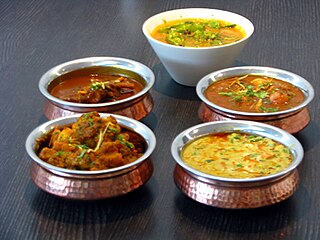
Curry is a variety of dishes originating in the Indian subcontinent that use a complex combination of spices or herbs, usually including ground turmeric, cumin, coriander, ginger, and fresh or dried chilies. Curry is generally prepared in a sauce. Curry dishes prepared in the southern states of India, where the word also originated, may be spiced with leaves from the curry tree.

Asian cuisine includes several major regional cuisines: East Asian, Southeast Asian, South Asian, Central Asian, and Western Asian. A cuisine is a characteristic style of cooking practices and traditions, usually associated with a specific culture. Asia, being the largest and most populous continent, is home to many cultures, many of which have their own characteristic cuisine.

Pakistani cuisine can be characterized by a blend of various regional cooking traditions of the Indian subcontinent, Central Asia as well as elements from its Mughal legacy. The various cuisines are derived from Pakistan's ethnic and cultural diversity.

Momo is a type of South Asian dumpling, popular across the Indian subcontinent and the Himalayan regions of broader South Asia. Momos are native to Tibet, Bhutan, Nepal, North Indian region of Ladakh, Northeast Indian regions of Sikkim, Assam, and Arunachal Pradesh, and Darjeeling, West Bengal, India. It is similar to Chinese baozi and jiaozi, Mongolian buuz, Japanese gyoza and Korean mandu, but heavily influenced by cuisine of the Indian subcontinent with Indian spices and herbs.

Singaporean cuisine is diverse and contains elements derived from several ethnic groups, as a result of its history as a seaport with a large immigrant population. Influences include the cuisines of the native Malays, the largest ethnic group, the Chinese and the third largest ethnic group, the Indians as well as Indonesian, Peranakan and Western traditions. Influences from other regions such as Sri Lanka, Thailand and the Middle East are also present.

Puri is an unleavened deep-fried bread, originating from South Asia. It is eaten for breakfast or as a snack or light meal. It is usually served with a savory curry or bhaji, as in Puri bhaji, but may also be eaten with sweet dishes.

Bangladeshi cuisine is the national cuisine of Bangladesh. Bangladeshi cuisine has been shaped by the diverse history and river-line geography of Bangladesh. The country has a tropical monsoon climate.

The cuisine of Karnataka includes many vegetarian and non-vegetarian cuisines. It is one of the oldest surviving cuisines and traces its origin to the Iron Age. Ragi is mentioned in the historical works of the great poet Adikavi Pampa and in the ancient Sanskrit medical text Sushruta Samhita. The varieties of the Karnataka cuisine have drawn influence from and influenced the cuisines of neighbouring states like Tamil Nadu, Andhra Pradesh and Kerala. Although the ingredients differ from one region to another, a typical Kannadiga Oota includes the following dishes in the order specified and is served on a banana leaf: Uppu (salt), Kosambari, Pickle, Palya, Gojju, Raita, dessert, Thovve, Chitranna, rice, and ghee.

Gujarati cuisine is that of the state of Gujarat, in western India. Despite having an extensive coastline providing wholesome seafood, Gujarat is primarily a vegetarian state due to the influence of Jain vegetarianism. Many communities, however, do include seafood, chicken, and mutton in their diet.

Dal bhat is a traditional meal from the Indian subcontinent, popular in many areas of Nepal, Bangladesh and India. It consists of steamed rice and a cooked lentil soup called dal. It is a staple food in these countries. Bhat or Chawal means "boiled rice" in a number of Indo-Aryan languages.
Newa cuisine is a subset of Nepalese cuisine that has developed over centuries among the Newars of Kathmandu, Nepal. Newa cuisine is the most celebrated food variety in the country that consists of over 200 dishes. It is more elaborate than most Nepalese cuisines because the Kathmandu Valley has exceptionally fertile alluvial soil and enough wealthy households to make growing produce more profitable than cultivating rice and other staples.

Cuisine of Uttar Pradesh is from the state of Uttar Pradesh(UP) located in Northern India. The Cuisine of UP has a large variety of dishes. The cuisine consists of both vegetarian and non-vegetarian dishes of different varieties. Being a large state, the cuisine of UP share lot of dishes and recipes with the neighboring states of Delhi, Uttarakhand, Haryana and Apart from native cuisine, Mughlai and Awadhi are two famous sub types of cuisine of the state.

Malaysian Indian cuisine, or the cooking of the ethnic Indian communities in Malaysia consists of adaptations of authentic dishes from India, as well as original creations inspired by the diverse food culture of Malaysia. Because the vast majority of Malaysia's Indian community are of South Indian descent, and are mostly ethnic Tamils who are descendants of immigrants from a historical region which consists of the modern Indian state of Tamil Nadu and Sri Lanka's Northern Province, much of Malaysian Indian cuisine is predominantly South Indian inspired in character and taste. A typical Malaysian Indian dish is likely to be redolent with curry leaves, whole and powdered spice, and contains fresh coconut in various forms. Ghee is still widely used for cooking, although vegetable oils and refined palm oils are now commonplace in home kitchens. Before a meal it is customary to wash hands as cutlery is often not used while eating, with the exception of a serving spoon for each respective dish.
Fijian food has traditionally been very healthy. Fijians prefer a more tuber and coconut based diet. High caloric foods are good for hard-working villagers who need extra calories while working on their farms but this causes a range of chronic illness such as obesity. Fiji is a multicultural country and is home to people of various races. In most Fijians' homes, food of other cultures is prepared on a regular basis such as Indian curries and Chinese dishes. Fiji is also famous for its seafood.











